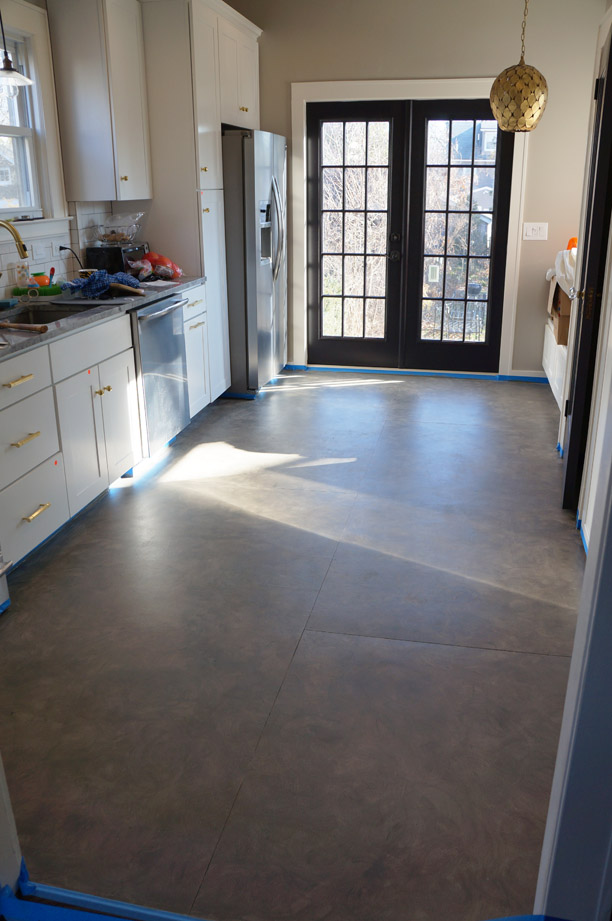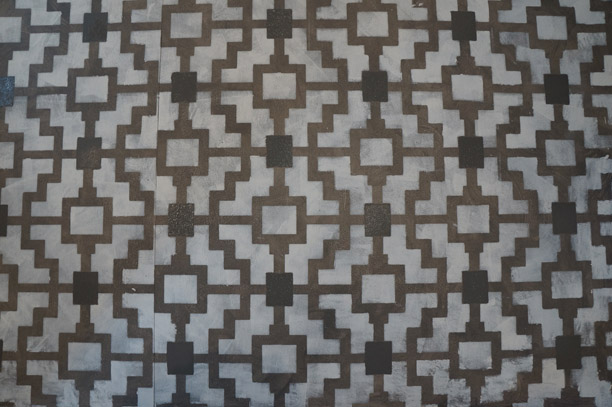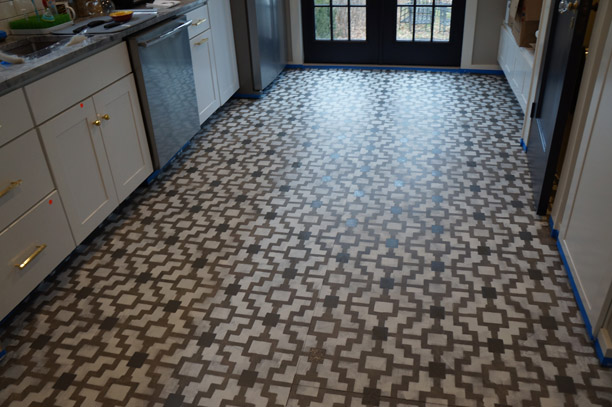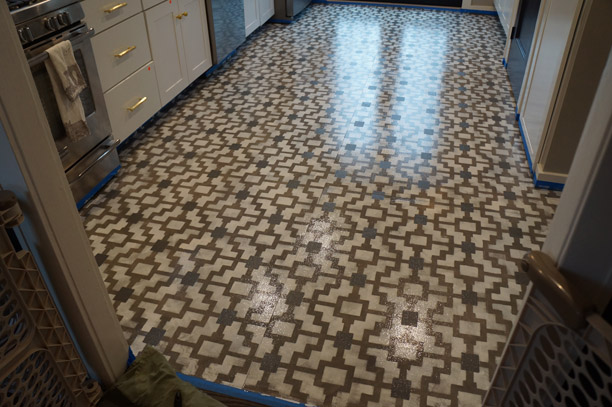Well, I know some of you have seen some photos of the kitchen floor via facebook and instagram, but I have yet to do a full on blog post about the process and final result. And I know it is eagerly awaited. After some serious overcommitment and some resulting stress-induced sickness (and a toddler with two ear infections) I’ve come back up for air and made time for a few blog updates. So here goes.
I showed you the whole glazing process a few weeks back (this was before I was thwarted by the flu). Well, that was by far the easy and fast part. To recap, here is what the floor looked like before. And here is what it looked like with the glaze
And here is what it looked like with the glaze
And this was the idea for the final concept.
So, I received my Shipibo Allover Stencil from Cutting Edge Stencils and flattened it out to get ready for the the stencil process. I started at the top end of the room toward the middle and then worked out using a very dry firm mini foam roller and not much pressure (as per their suggestions).
Because I wasn’t worried about an even coat – I wanted a patina’d look afterall – the first few rows went fairly quickly.
The edges and corners, however got a little rough. Paint was starting to goop under the stencil despite how little pressure I was using and there was more going back and wiping both the floor and the stencil. The edges weren’t quite as crisp because of all the goopage and the fact that paint started drying around the edges of the stencil openings causing the lines to be less straight (although that doesn’t bother me so much and I’m glad that the middle, most noticeable portion looks the best). By far the most challenging part was going in and out of the corners. You can bend a stencil to pretty close to a 90 degree corner but try bending it 90 degrees in two directions and it does not want to cooperate. I ended up having to use a brush and doing some hand fudging. Here is what it looked like further along.
By the time I finished all the edges and corners the center was dry enough to walk on (especially since so little paint was used). I was pretty happy with the results and was debating leaving it at that. The black squares in the above concept seemed like a commitment. But I had a couple of hours left (like an hour and a half) before picking up Bryan at daycare and I figured I’d go for it. Minor glitch – I had not purchased black paint. Oops. So I opted to use the dark charcoal grey that I used for the glaze. I had so much left over and in undiluted form I figured it would contrast nicely and maybe be more subtle than the black. Other minor glitch – I didn’t end up looking at my original diagram, so I opted for a different square to stencil. This ended up being a blessing in disguise. Instead of stenciling over a white square that had already been painted, I stenciled over a negative space grey square. This was better because it allowed for more error on the edges. Imagine if I’d stenciled my grey square and had a little white edge poking through all around? Anyway, I used a file folder and traced my floor with a sharpie, cut out my stencil and went at it (this time with the brush only). I think the results were better than if I had gone with my original plan!
Nice job! You were probably so happy to be done in time to pick Bryan up from day care…. is probably what you are thinking. But no, there is more. Polyurethane! A couple of days later, I moved on to the next step – clear coat. This was a tuesday night (first coat), wednesday morning (second coat) affair involving a baby gate for the cat and one minor freak out when I decided to touch up a spot in the middle of the floor and skated over the wet and very slippery polyurethane barefoot.
In the end it turned out great and will hopefully prove to be both pretty and durable – and WAY less expensive had I gone the route of the encaustic tile which I was trying to mimic. I’d give stenciling two thumbs up – definitely something I’d do again especially on a floor where the impact and difference was so large. Stay tuned for a stencil giveaway tomorrow!!!!!












